Title: 7 famosi monumenti in Italia da non perdere
No other place in the world rivals the options of wonderful man-made marvels found in Italy. Praised in guidebooks and travel magazines, these landmarks tell centuries of fascinating history while fuelling dreams of la dolce vita.
Nessun altro posto al mondo ha così tante meraviglie create dall’uomo come l’Italia. Celebrati nelle guide e nelle riviste di viaggio, questi monumenti raccontano secoli di affascinante storia, alimentando il sogno della dolce vita.
There’s no doubt that all of them are “must sees” in their own way. However, here’s a list of some of the most famous monuments in Italy that should be at the top of any travel itinerary, especially if it’s your first time in the country.
Anche se sono tutti da considerare “imperdibili” nella loro unicità, di seguito trovate una lista di famosi monumenti italiani che non dovrebbero mai mancare in un itinerario di viaggio, soprattutto se è la prima volta che si visita il paese.
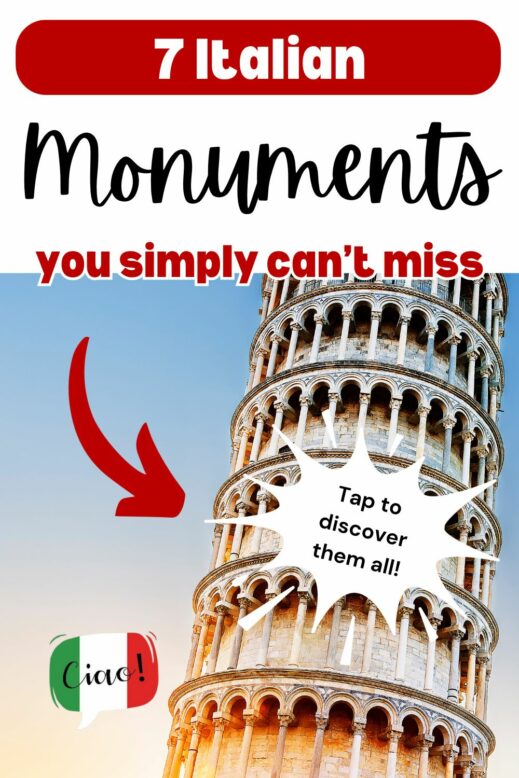
This article is part of our Bilingual Blog series, where we share useful information and tips about non-language related aspects of Italian culture such as food, music, travel and more. These articles have been written in Italian and English to give our readers the opportunity to improve their reading skills whilst learning something new about Italy.
1. The Colosseum in Rome
Il Colosseo a Roma
One of the most famous monuments in Italy that you must add to your Rome itinerary – and one of the world’s most impressive pieces of architecture – is the Colosseum. The Flavian emperors built it as a gift to the Romans in the first century CE and equipped it with surprisingly sophisticated stage machinery. The venue’s calendar included a packed schedule of events such as gladiator games, mock sea battles, executions, and mythological dramas.
Uno dei monumenti più famosi d’Italia – e una delle opere architettoniche più impressionanti del mondo – è il Colosseo. Nel I secolo dC, gli imperatori della dinastia Flavia lo fecero costruire come dono ai romani e lo dotarono di macchinari scenici sorprendentemente sofisticati per l’epoca. In calendario vi era sempre un fitto programma di eventi tra cui giochi di gladiatori, finte battaglie navali, esecuzioni e drammi mitologici.
Unlike modern events, ancient Romans got free admission to the Colosseum as well as complimentary food. It was the emperor’s way of showing off his grandeur and generosity to the people of Rome while also keeping them entertained and distracted from the political problems of the day.
A differenza degli eventi moderni, l’ingresso al Colosseo così come il cibo erano gratuiti per gli antichi romani. Era un modo per l’imperatore di mostrare la sua grandezza e generosità al popolo, che veniva così intrattenuto e allo stesso tempo distratto dai problemi politici del tempo.

Fun fact: when the Colosseum became a quarry for building materials during the Middle Ages and the Renaissance, some of its “pieces” were used for the construction of St Peter’s Basilica.
Curiosità: quando il Colosseo divenne una cava di materiali da costruzione durante il Medioevo e il Rinascimento, alcuni dei suoi “pezzi” furono utilizzati per la costruzione della Basilica di San Pietro.
Are you interested in visiting Rome on a budget? Then check out these great tips from our friends at Rome Actually!
2. The Cathedral of Santa Maria del Fiore in Florence
Il Duomo di Santa Maria del Fiore a Firenze
Also known as the Duomo, Florence’s Cathedral of Santa Maria del Fiore is one of those Italian landmarks you just can’t miss. Its exterior is a sight to behold, with a splendid ensemble of white, pink, and green marble and intricate sculptures. But the real rockstar is Brunelleschi’s giant dome, a double-shell construction with a self-supporting structure that’s a true masterpiece of Renaissance architecture. Plus, its inside is covered in the grand Last Judgement fresco by Giorgio Vasari, one of the world’s most iconic pieces of religious art.
Il Duomo di Santa Maria del Fiore a Firenze è uno dei più famosi monumenti in Italia. La sua facciata con intricate sculture e splendidi marmi bianchi, rosa e verdi è un vero spettacolo. Ma la vera attrazione è la gigantesca cupola del Brunelleschi. Si tratta di una costruzione a doppia calotta con struttura autoportante che è un vero capolavoro dell’architettura rinascimentale. Inoltre, l’interno della cupola ospita il grandioso affresco del Giudizio Universale di Giorgio Vasari, uno dei capolavori di arte religiosa più iconici al mondo.
Many prestigious artists have left their mark on this iconic monument in Florence. Lorenzo Ghiberti engraved the magnificent bronze doors of the adjacent Baptistry of St John – a commission that saw him compete against Brunelleschi – while Giotto and Andrea Pisano built the bell tower.
Molti prestigiosi artisti lavorarono a questo iconico monumento di Firenze: Lorenzo Ghiberti incise la magnifica porta bronzea dell’adiacente Battistero di San Giovanni – lavoro che lo vide competere con Brunelleschi – mentre Giotto e Andrea Pisano costruirono il campanile.

Fun fact: Brunelleschi was a goldsmith with no previous architectural experience of note when he designed the cathedral’s dome – talk about nothing being impossible!
Curiosità: Brunelleschi era un orafo e non aveva particolari esperienze nel campo architettonico quando progettò la cupola del Duomo: quando si dice che niente è impossibile!
3. St Mark’s Basilica in Venice
La Basilica di San Marco a Venezia
It’s hard to describe the St Mark’s Basilica in Venice as anything but a spectacle. This famous Italian landmark is not like any other church in the West. In fact, it’s a stunning example of Byzantine architecture, boasting golden domes and intricately decorated walls and ceilings.
La Basilica di San Marco a Venezia non può che essere descritta come spettacolare. Questo famoso monumento italiano è diverso da qualsiasi altra chiesa in Occidente. Si tratta infatti di uno straordinario esempio di architettura bizantina, con cupole dorate, pareti e soffitti riccamente decorati.
As the story goes, the basilica was originally built in the 9th century to hold the body of St. Mark the Evangelist that Venice merchants stole from Alexandria, Egypt. This epic tale is pictured in an ancient mosaic above the left door at the entrance. Over time, the church underwent several modifications, and many of its treasures were snatched from Constantinople during the city’s expansion in the Middle Ages. The final result is a gorgeous mix of styles.
Si narra che la basilica sia stata originariamente costruita nel IX secolo per contenere le spoglie di San Marco Evangelista che alcuni mercanti veneziani avevano rubato da Alessandria d’Egitto. Questo racconto epico è raffigurato in un antico mosaico sopra la porta sinistra all’ingresso. Nel corso del tempo, la chiesa subì diverse modifiche e molti dei suoi tesori giunsero da Costantinopoli durante l’espansione della città nel Medioevo. Il risultato finale è uno splendido mix di stili.

Fun fact: there are over 8,000 square meters of mosaics inside the basilica. For comparison, the Jardin Majorelle in Marrakech are just about the same size!
Curiosità: ci sono oltre 8.000 metri quadrati di mosaici all’interno della basilica – più o meno l’equivalente dei Giardini Majorelle a Marrakech!
4. The Leaning Tower of Pisa
La Torre di Pisa
Known for its trademark tilt, the Leaning Tower of Pisa is an architectural wonder of the world. Built in the 12th century to be the tallest tower of its age, it began to tilt during construction due to the soft ground. Eventually, the tilt got progressively more severe, and in 1990 the Tower was forced to close for safety reasons. Several efforts were made to stabilize the structure and make it safe for visitors, who can now visit easily.
Famosa per la sua caratteristica inclinazione, la Torre di Pisa è una meraviglia architettonica famosa in tutto il mondo. Eretta nel XII secolo per essere la torre più alta della sua epoca, iniziò a inclinarsi già durante la costruzione a causa del terreno cedevole. Con il passare del tempo, l’inclinazione peggiorò e nel 1990 la Torre fu chiusa per motivi di sicurezza. Da allora sono stati fatti diversi interventi per stabilizzare la struttura e renderla sicura per i visitatori, che ora possono visitarla facilmente.
The Tower is a part of the Piazza dei Miracoli, a beautiful walled complex that includes other ancient structures such as the Cathedral, the Baptistery, and the Monumental Cemetery. You can climb the 296 steps to the top of the Tower, where you can see the whole city.
La Torre fa parte della Piazza dei Miracoli, un bellissimo complesso murato che comprende altre strutture antiche come il Duomo, il Battistero e il Cimitero Monumentale. È possibile salire i 296 gradini fino alla cima della Torre, da dove si gode di una meravigliosa vista sull’intera città.

Fun fact: Pisa is home to several other tilting towers that are not quite as famous but are just as impressive, making a visit to this charming Tuscan town all the more interesting.
Curiosità: ci sono molte altre torri pendenti a Pisa, meno famose ma altrettanto notevoli, che rendono l’esplorazione di questa affascinante città toscana ancora più interessante.
5. Milan’s Cathedral
Il Duomo di Milano
A common misconception is that Milan is just about business and fashion, but the city’s Cathedral – one of the largest churches in the world – clearly proves otherwise. This grand Gothic church stands as a symbol of the city’s rich architectural and artistic heritage. Commissioned by Gian Galeazzo Visconti, the ruler of Milan, in 1386, it took nearly six centuries, thousands of workers and a brand-new canal system to build! That speaks volumes about his grand plan!
Spesso si pensa che Milano sia solo business e moda, ma il Duomo della città – una delle chiese più grandi al mondo – dimostra chiaramente il contrario. Questa maestosa chiesa gotica, infatti, è il simbolo del ricco patrimonio architettonico e artistico della città. Il Duca di Milano Gian Galeazzo Visconti la commissionò nel 1386 e ci vollero quasi sei secoli, migliaia di lavoratori e la creazione di un nuovo canale per costruirla! Tutto ciò la dice lunga sulla portata del suo progetto!
Milan’s Cathedral also boasts an astonishing number of statues – 3,400 to be precise – that are a testament to the city’s rich history and culture. They represent both religious and secular figures. You can even spot historical figures like the boxer Primo Carnera and the composer Arturo Toscanini, which are used to celebrate Italian culture.
Il Duomo di Milano vanta anche un numero sorprendente di statue – 3.400 per la precisione – che testimoniano la ricca storia e cultura della città. Rappresentano sia figure religiose che laiche, tra cui personaggi come il pugile Primo Carnera e il compositore Arturo Toscanini, a voler celebrare la cultura italiana.
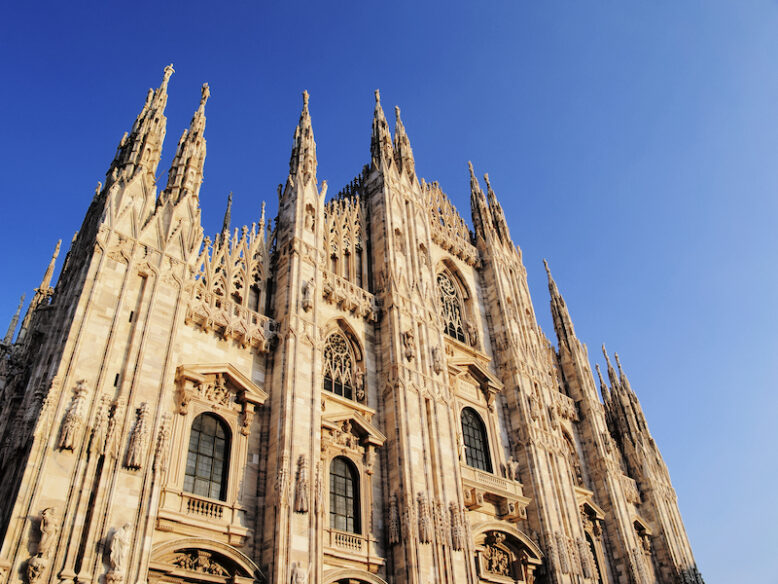
Fun fact: the Lombard artist Lodovico Pogliaghi realised the Cathedral’s central door, and his museum near Varese has a wonderful life-size plaster model of it.
Curiosità: l’artista lombardo Lodovico Pogliaghi realizzò la porta centrale del Duomo, e il suo museo vicino a Varese ne conserva un meraviglioso plastico a grandezza naturale.
6. The Sassi di Matera
I Sassi di Matera
Staring out across Matera’s old town, it’s hard not to be awestruck by the enchanting views of the Sassi. Especially at night, when the whole place turns into a Nativity-like scene. Meaning “stone”, the word Sassi refers to clusters of ancient cave dwellings carved into the rock that have been continuously inhabited from prehistoric times until the 1950’s. That’s when the Italian government forced most of Sassi’s residents to move to more modern areas within the city, as they were living in poverty with no access to basic amenities like electricity or running water.
Quando si volge lo sguardo verso il centro storico di Matera, è difficile non rimanere colpiti dall’incantevole vista dei Sassi. Soprattutto di notte, quando l’intero sito si trasforma in un vero e proprio presepe. La parola Sassi fa riferimento a due quartieri formati da antiche abitazioni rupestri scavate nella roccia che furono abitate ininterrottamente dalla preistoria fino agli anni ’50. Fu allora che il governo italiano costrinse la maggior parte dei residenti dei Sassi a trasferirsi in aree più moderne della città, poiché vivevano in povertà e non avevano accesso a servizi di base come elettricità o acqua corrente.
With time, these fascinating examples of ancient architecture have been completely renovated to host restaurants, museums and modern B&Bs. Matera became the first town in southern Italy to enter the UNESCO World Heritage Site list in 1993, moving from being the “shame of Italy” to offering a unique travel experience that’s sure to stay with you forever.
Con il tempo, questi affascinanti esempi di architettura antica sono stati completamente ristrutturati per ospitare ristoranti, musei e moderni B&B. Matera è diventata la prima città del sud Italia a entrare nella lista del Patrimonio Mondiale dell’UNESCO nel 1993, passando dall’essere la “vergogna d’Italia” al rappresentare un’indimenticabile esperienza di viaggio.
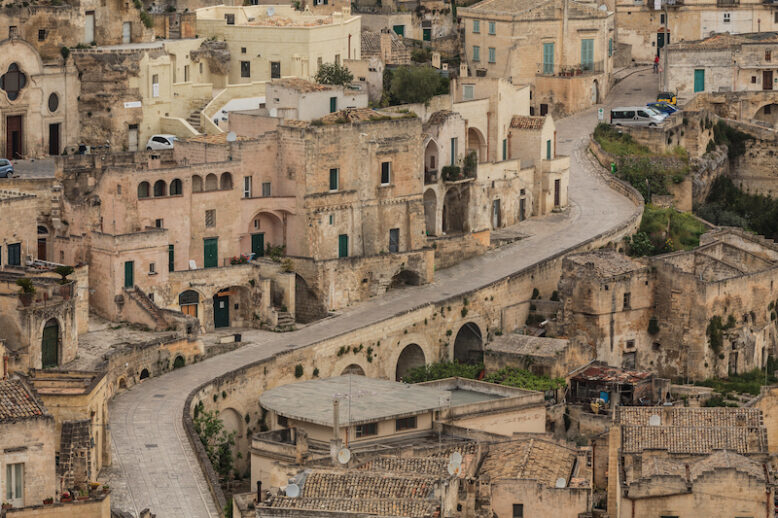
Fun fact: There are literally tens of ancient churches in Matera, including the “Crypt of Original Sin” that boasts beautiful frescoes and is considered the Sistine Chapel of rock churches.
Curiosità: ci sono decine di chiese antiche a Matera, tra cui la cosiddetta “Cripta del Peccato Originale”. Al suo interno ci sono bellissimi affreschi che le sono valsi il soprannome di Cappella Sistina delle chiese rupestri.
7. The Royal Palace of Caserta
La Reggia di Caserta
There’s a reason this architectural gem north of Naples is on everyone’s list of famous monuments to see in Italy. Namely, it’s breathtaking. Conceived to rival Versailles, the Royal Palace of Caserta is an opulent Baroque palace that came to life in the second half of the 18th century by the famed architect Luigi Vanvitelli (the same behind the Trevi Fountain and St. Peter’s Dome) to host the court of the Bourbon king of Naples, Charles III. It was indeed a pharaonic endeavor involving over 1200 rooms and costing the equivalent of 300 billion euros.
Anche questo gioiello architettonico a nord di Napoli è in tutte le liste dei più famosi monumenti da vedere in Italia. E la ragione è semplice: è davvero mozzafiato. Concepito per competere con Versailles, la Reggia dei Caserta è uno sfarzoso palazzo barocco prese vita nella seconda metà del XVIII secolo per mano del famoso architetto Luigi Vanvitelli (lo stesso dietro la Fontana di Trevi e la Cupola di San Pietro) e ospitò la corte del re di Napoli, Carlo III. Fu davvero un’impresa faraonica che vide la costruzione di oltre 1200 camere e costò l’equivalente di 300 miliardi di euro.
Outside, there’s plenty more to see. The massive royal park covers an area of 120ha scattered with everything from landscaped gardens to ornamental fountains, cascades, and pools for hours of fun exploring.
All’esterno, c’è molto altro da vedere. L’enorme parco reale copre un’area di 120 ettari punteggiata di giardini, fontane ornamentali, cascate e vasche che assicurano ore di meravigliosa esplorazione.
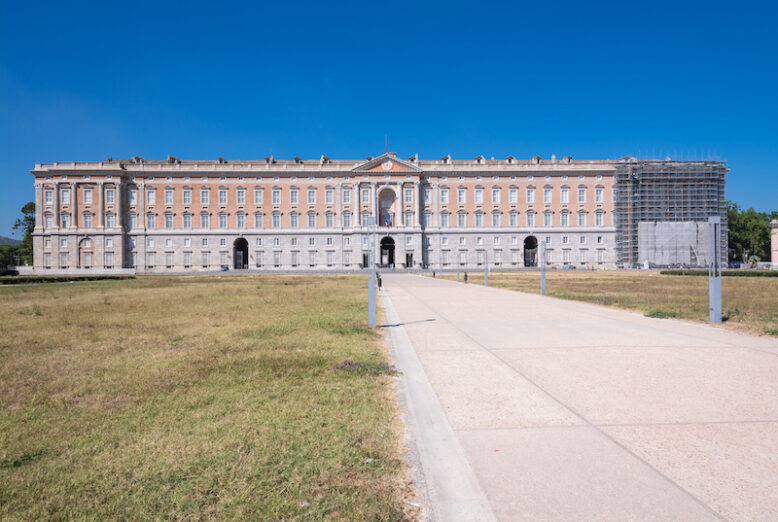
Fun fact: the Royal Palace of Caserta features the first example of Italy’s most unique piece of furniture: the bidet!
Curiosità: la Reggia di Caserta ospita il primo esempio di un curioso complemento d’arredo tipicamente italiano: il bidet!
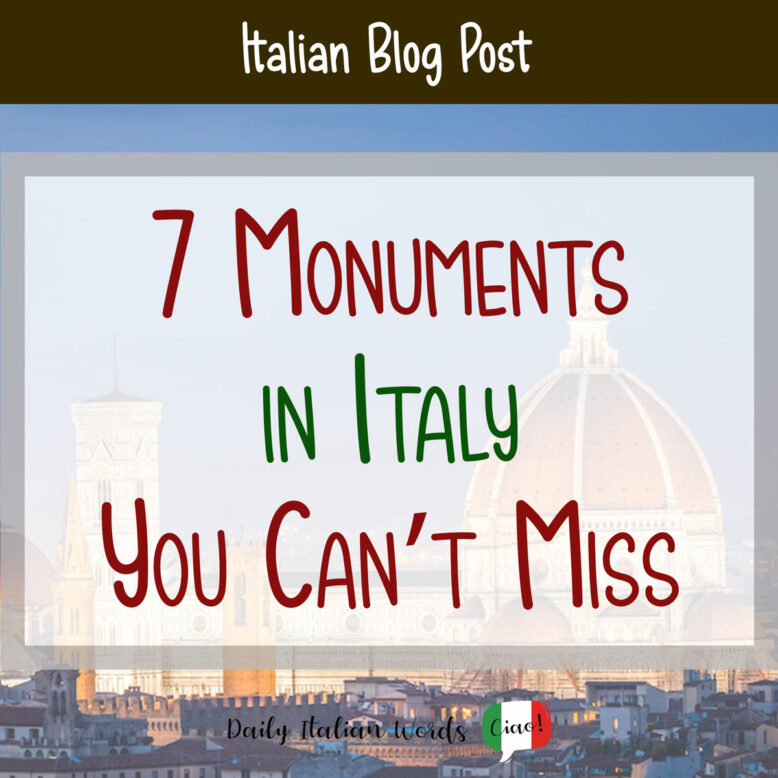

Valentina Nicastro is a travel writer in love with her home country, Italy. Having travelled widely around the globe, she realised there was more to explore closer to home and decided to put the passport aside for a while. When she is not immersed in documenting Italy, you’ll find her donning her communication consultant hat, weaving words as a content writer and bridging linguistic divides as a translator.


